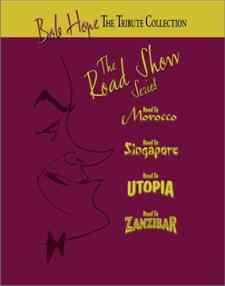
The Bob Hope Collection on
DVD
Ol' ski snoot is back with a vengeance in Universal Home Video's
collection of classic Bob Hope movies. We received a representative sampling
that included the boxed set "The Road Show Series" of "Road" movies as well as
two other classic Hopefests "The Paleface" and "The Ghost Breakers."
Probably the most famous of Hope's films is the Road Series, which
he made with Bing Crosby and Dorothy Lamour (among others, of course!). This
boxed set gives us four of them: Road to Singapore, Road to Zanzibar, Road to
Morocco and Road to Utopia, in chronological order. Each has its moments, but
the latter two are easily the funniest of the series, especially Utopia, which
is downright silly.
In each of the movies, Hope and Crosby are buddies out to make a
living via one minor con or another. In "Singapore," Crosby's running from a
woman and with sailor buddy Hope they head for the farthest piece of the planet
they can find. In "Zanzibar," they're a side show act that gets stranded in the
jungle after their human cannonball act (guess which one's lucky enough to be
the cannonball?) burns down the big top. In "Morocco," they're shipwreck
survivors tying to get home (but one of them - guess which one - gets sold into
slavery), and in "Utopia" they're ne'er do well prospectors searching for a
gold mine in turn of the century Alaska posing as a couple of thugs.
In each movie, Hope's the comedy relief and Crosby's the crooner
who always (well, almost always) gets the girl. And Lamour, not surprisingly,
is the girl.
It's interesting to see this team in action, and we mean action.
There are many of times in these movies, especially the first two, where
they're forced to fight with their fists for their lives. And though neither of
these guys could be considered an action star, the scriptwriters were on their
side and let them parlay a Pattycake ruse into an escape from yet another
dangerous situation.
It's also interesting to see a very young Anthony Quinn on hand in
two of the films in the role of the villain.
There's plenty of music here, too, with Hope and Crosby at their
vaudevillian best doing song and dance routines (and Crosby and Lamour crooning
a number of solos as well). But it's the interaction of Hope and Crosby that
makes these movies so memorable. They were obviously having a grand time on the
soundstage and that sense of fun was captured on film.
The "Road" movies are also available individually, as are the
other titles we were sent: The Ghost Breakers and The Paleface.
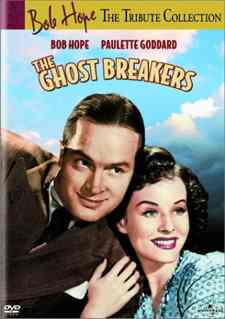
The Ghost Breakers is pretty funny, especially the line
where Hope compares Zombies to Democrats (how little has changed since 1940!).
Hope is Larry Lawrence, a radio show host about to go on vacation
when he rubs a crime boss the wrong way, is accused of a murder he didn't
commit, and has to find a place to hide out. That place turns out to be Cuba,
specifically an island off Cuba on which is a haunted castle owned by his new
friend Mary Carter (Paulette Goddard).
Mary has inherited this castle and, in the tradition of such
stories, is on her way there to take possession. But, according to lore, the
castle is already possessed, by the spirits of the dead, but Mary's gamely
bound to go there anyway to see what's up.
This gives Hope and his valet (Willie Best) an opportunity not
only to hide out, but to help out this damsel in distress as it seems that
nearly everyone else in the cast is out to get her - or at least to get her
castle.
It's pretty funny stuff as Hope manages to bumble his cowardly
(though not as cowardly as usual) way through the castle's mystery, saving the
beautiful girl in the process.
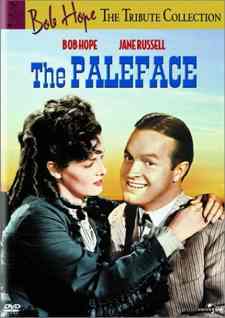
The Paleface is one of Hope's most famous movies. He stars
with Jane Russell, who plays Calamity Jane, the gunslingin' babe of legend.
She has just made a deal to become a federal agent in return for a
pardon. Hope is "Painless" Peter Potter, a frontier dentist of debatable skill,
who Jane uses as a cover for her mission into Indian country to bust a renegade
gang supplying arms to the Indians.
Painless figures he has it made when Jane marries him and they
head West on their honeymoon. But danger isn't far away in the wilds of the
West, and the cowardly Painless finds himself confronting bad guys both white
and red. Jane bails him out, of course, but without blowing her cover - so
their companions think Painless is the hero and she lets them - and him - go on
thinking that.
Eventually she reveals the truth to Painless and, though
devastated, he manages to screw up enough courage to save her life when the
renegade indians are going to burn her at the stake.
It's an enjoyable comic romp featuring Hope at his best, with a
lighthearted script and a good supporting cast that includes King Kong's Robert
Armstrong and Iron Eyes Cody, a native American who became famous during the
1970's thanks to a pro-ecology public service announcement that featured him
shedding a tear for Mother Earth. As for Russell, she's probably the weakest
thing in the movie, but was undoubtedly not hired because of her acting skills.
Hope's character is typical of his onscreen persona, and he gets
to give out some great lines (for example, he says "Brave men run in my family"
just before hightailing it) and do some great comic business.
The movie also spawned a sequel Son of Paleface, and was remade in
the 1960's as the Don Knotts vehicle "The Shakiest Gun in the West."
The video quality of these DVD's is very good. All are offered in
the movies' original fullscreen aspect ratio, which means they'll need to be
stretched or zoomed to fit the 16x9 TV screen, but even then they still exhibit
a very good black and white picture.
Even better, The Paleface is presented in its original full screen
Technicolor, and the picture quality is outstanding. We love the look of these
old color films, and the DVD medium showcases them perfectly. The Paleface is
bright and sharp and lovely to behold.
The audio is Dolby Digital mono and, typically, it isn't
particularly high fidelity. This isn't surprising for a bunch of 1940's movies,
however, and you can't blame the DVD medium for that. It's more than
acceptable, though.
The extras are pretty good, but some of them are (unfortunately)
repeated on the discs. The best extra is "Bob Hope and the Road to Success," a
documentary on the series. It's interesting and entaertaining, but it's also
repeated on each of the four discs.
Also on hand is a collection of shorter features we really
enjoyed, especially since they dealt with different aspects of Hope's career
during World War II when he began doing his famous shows for the troops.
Depending on the disc, you get a look at Hollywood's Victory Caravan, the
"Command Performance" shows, "Entertaining the Troops," etc.
Each disc also inlcudes a photo gallery, as well as production
notes, trailers, and cast/crew info.
It's a shame that so much of the supplementary material is
repeated from disc to disc. Since Hope has been around forever we figure
there's enough material to allow for new stuff on each disc. But as we've
pointed out many times before, it's the movie itself that's important and bonus
materials - as their name suggests - is a bonus.
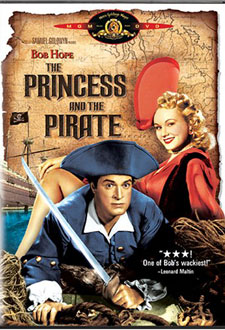
The Princess and the Pirate on DVD
Bob Hope is at the top of his game in the Princess and the Pirate,
a lovely Technicolor parody of pirate movies – and Bob Hope movies in
general.
Hope, as is often the case, plays an inept entertainer trying to
save his own sorry butt – and mostly by osmosis the lovely butt of
princess Virginia Mayo as well.
She’s on the run from an arranged marriage and falls into the
clutches of a governor (Walter Slezak) and the pirate (Victor McLaglen) with
whom he’s in cahoots, who are hoping to ransom her off to her father.
It’s typical Bob Hope fun, as ridiculous as ever, but
it’s hard not to laugh at Hope’s self-effacing jokes and the double
entendres – and there’s a nifty “surprise” ending
that’s worth the price of admission on its own.
Walter Brennan nearly steals the show with his portrayal of a
whacko pirate who may not be quite as whacko as he’s made out. Despite how
Brennan leaps off the screen, however, Hope manages to upstage him, with a
couple of his best scenes being when he tries to conceal a tattoo on his chest
while taking a bath with the governor and also when he's trying to impersonate
the pirate. There’s a short homage (or ripoff?) of an old Marx Brothers
mirror routine as well.
And Virginia Mayo is quite the babe! She can act and sing,
too.
As a DVD, this is really a mixed bag. The picture, which is
presented in its original full frame (not 16x9 TV compatible) is alternately
either sharp and gorgeous, or simply awful. It’s like the old saw
“when it’s good it’s very, very good, but when it’s bad
it’s horrible." Perhaps a restoration is called for here, and the film,
which features great production values, certainly deserves it.
Audio is fine, considering the age of the movie.
The Princess and the Pirate, from MGM Home Entertainment
94
min. full frame (1.33:1, not 16x9 TV compatible), Dolby Digital mono
Starring Bob Hope, Virginia Mayo, Walter Slezak
Produced by Samuel
Goldwyn
Written by Don Hartman, Melville Shavelson and Everett Freeman,
Directed by David Butler
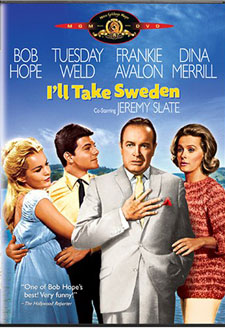
I’ll Take Sweden on DVD
Bob Hope in a sex farce?
That’s exactly what I’ll Take Sweden gives you, as Hope
plays an executive who, desperate to save his daughter (Tuesday Weld) from the
boy (Frankie Avalon) who’s sniffing around her, drags her away to Sweden
to put thousands of miles between them.
As it turns out, the Sweden of this 1960’s vintage film is a
free wheeling sexual playground where it’s normal to “try on a pair
of shoes before buying it.” And wouldn’t you know, the daughter
starts falling for a Swedish playboy (Jeremy Slate), who expects to try on
those shoes before buying them.
Further complicating the situation, widower Hope falls for an
attractive Swedish woman (Dina Merrill), who also has no problem trying on a
partner before buying. Hope, of course, is uptight and confused and wants to be
a role model for his daughter - and finding himself in the middle of the
‘60’s sexual revolution freaks him out.
Naturally, it all works out in the end, thanks mostly to the moral
grounding Hope’s character gave to his daughter throughout her life.
While there is plenty of opportunity for preaching, either for or
against pre-marital sex, the movie chooses to remain a comedy and that
ultimately helps make it work.
Hope is Hope, and that’s fine. The rest of the cast is
attractive and convincing and the overall result is an enjoyable romp through
the angst of the 1960’s.
The DVD is very good, though sparse and not anamorphic. It is
presented in letterboxed widescreen (not 16x9 TV compatible), so owners of
widescreen TV’s prone to burn in will have to zoom it to fill the screen
to keep their TV investments safe. We watched it letterboxed on a 4x3 TV and
judged the picture quality overall as very good.
Audio is Dolby Digital mono and it’s fine.
I’ll Take Sweden, from MGM Home Entertainment
97 min.
letterboxed widescreen (1.66:1, not 16x9 TV compatible), Dolby Digital mono
Starring Bob Hope, Tuesday Weld, Frankie Avalon, Dina Merrill, Jeremy Slate
Produced by Edward Small
Written by Nat Perrin, Bob Fisher and Arthur Marx,
directed by Frederick de Cordova
Tell us at TechnoFile what YOU think






